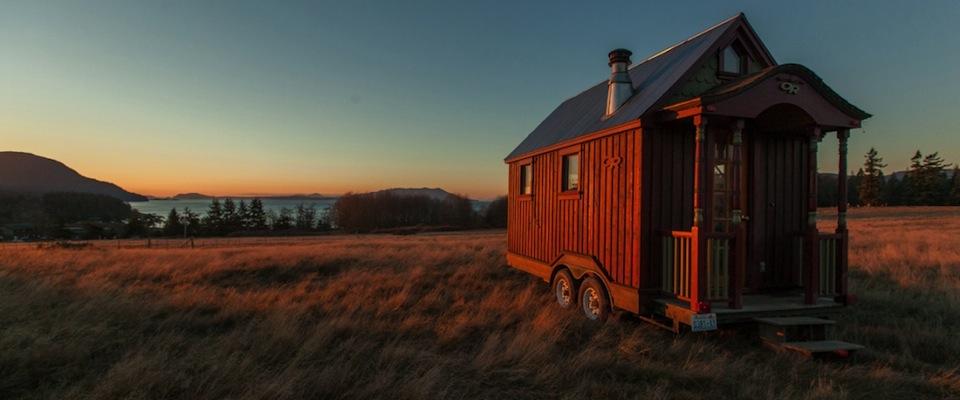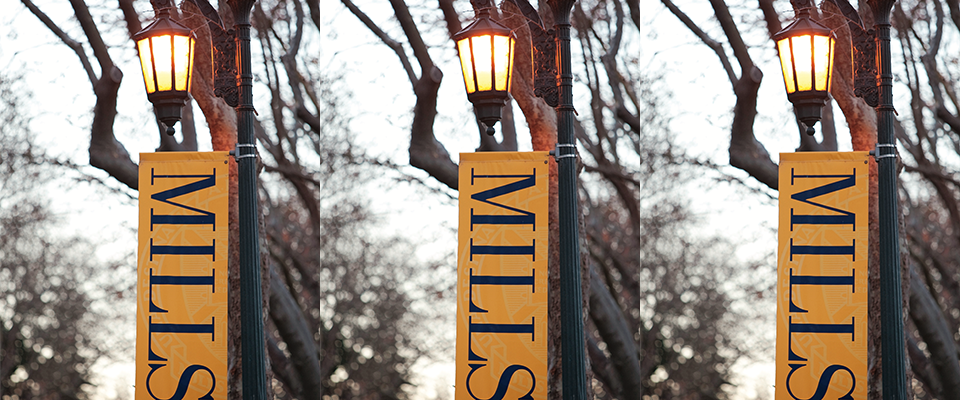A team of Cal students is setting out to demonstrate one possible solution to the Bay Area’s gentrification and escalating housing costs: Go tiny.
By next fall, the group plans to finish building a net-zero energy, approximately 250-square-foot home-on-wheels at UC Berkeley’s Richmond Field Station, a 152-acre plot that the university plans to eventually transform into the Berkeley Global Campus.
It’s a two-year quest—with the first year focused just on design—during which the students hope to demonstrate that UC Berkeley and the city of Richmond can preserve affordable housing options once the Global Campus development is a reality.
Editors’ note: Three students working on the project are reporting on their tiny house endeavor at the 2015 U.N. Climate Change Conference in Paris.
“It’s designed to address some of the issues facilitated with building such a large campus in a city with a lot of low income residents who are rent burdened,” says Ian Bolliger, a UC Berkeley Energy and Resources Group Ph.D. student leading the tiny house team that dubbed its project Tiny House in My Backyard, or THIMBY. “Displacement is a big issue where you bring in tens of thousands of people in this campus, so we’re looking (to create) housing that will be mobile and affordable.”
The team envisions that the houses could be available for anyone who’s living in Richmond—whether they’re Berkeley Global Campus faculty, students, researchers, staff or community residents.

In July, Richmond passed a rent control ordinance that is to take effect next month. But a study released in February by The Haas Institute for a Fair and Inclusive Society found that gentrification has already hit the city, with swelling housing prices and the loss of more than a third of the city’s African American population from 2000 to 2013.
Longtime Richmond resident Edith Pastrano says she is concerned about the impact that the Global Campus could have on her community—both in terms of gentrification and displacement.
“I want to stay in Richmond and see it transform into something bigger and better,” says 25-year-old Pastrano, who rents a three-bedroom apartment with her family. “But I don’t have that sense of security that I’ll be able to continue living here.”
In that sense, she is receptive to the idea of tiny houses dotting the local landscape as a temporary solution.
“It’s a bizarre yet innovative way to see the issue that we have at hand,” she said. “It really does make one think about what’s really going on—and what other solutions are out there.”
The Berkeley students come from a variety of disciplines, including mechanical engineering, physics, law, environmental design and architecture. Bolliger, a climate science researcher, says the project appealed to him as a way to get hands-on building experience. “It’s a physical project,” he says, “which is a nice complement to the theoretical activities and endeavors in graduate school.”
The team will enter its abode in a collegiate tiny house competition initiated by the Sacramento Municipal Utility District, competing against about a dozen other California universities, including Laney College, UC Santa Cruz, Stanford and the University of Southern California.
The completed homes will be displayed to the public alongside a mini-home resource fair at Sacramento State University in October of 2016.
The Berkeley team’s house—which will be 8.5 feet wide and between 26 to 30 feet long—will be powered by a 1.7 kW solar system, produce as much energy as it consumes (qualifying as a net-zero structure), and operate entirely off the electrical grid.
Tiny house designers employ a number of space-saving tricks to squeeze in the basic requirements needed for living. Sleeping quarters are usually elevated into a loft area, accessible via a ladder (sometimes stairs which double as storage spaces). Seating areas lining the side of the house can pull out into beds to accommodate visitors or children. Dining tables are usually the size of café tables for two, while others fold up into the wall. And wet baths (where the shower is not walled off from the toilet) are sometimes used as the ultimate space saver.
Though living small is nothing new—Henry David Thoreau’s residence at Walden Pond, for instance, measured just 150 square feet—what its evangelists call the “tiny house movement” largely credits Sebastopol resident Jay Shafer with propelling its popularity.
Building the houses on wheels allows residents, for the most part, to be classified as RVs and skirt around city building and zoning codes that have minimum room size requirements. (Some places, such as Eugene, Ore., have begun to clarify how residents can build tiny houses that meet code, while a new ordinance in San Diego will allow detached houses of at least 150 square feet to be built).
But what’s the difference between these homes and an RV? Tiny house aficionados say that they’re typically built to traditional house standards and with higher quality materials. Shafer, who in 2007 famously gave Oprah Winfrey a tour of the 96-square-foot house he constructed on wheels, was the first to start selling tiny house plans—alongside live-in ready tiny houses—to the masses.
Since then, spurred on by workshops given by Shafer and other advocates such as Olympia, Wash.’s Dee Williams, an increasing number of DIY-homebuilders have come out of the woodwork, so to speak, showcasing their tiny homes online via personal blogs and YouTube videos. Cable television even launched a Tiny House Nation reality series (which furnished the photographs of finished tiny house designs depicted within this article.)
The Sacramento Municipal Utilities District-sponsored contest, modeled on the U.S. Department of Energy’s Solar Decathlon, appears to be the first of its kind held by a utility. Staffer Suzette Bienvenue says it was a way to increase student access to green building or construction management experience. The utility also wanted to inspire and educate the public about the potential for tiny houses as sources of sustainable, energy efficient and budget-conscious living.
“Many people, especially in Sacramento, aren’t used to living in smaller spaces,” says Bienvenue. “For the most part, people don’t really understand the concept…It’s a good (way) to talk about this, their energy usage and how can they save money by making better energy choices.”
The Berkeley team—which has about $30,000 to play with from a combination of grants and academic department support—has found that the greatest design challenge thus far has been how to balance the house’s energy-efficient requirements and space constraints.
“It’s a challenge for tiny homes in general because you’re trying to be space efficient and (also) trying to make a home off-grid with a very small solar footprint to supply all of its energy,” says Bolliger. “One of the things we’ve learned throughout the first year is that there’s not a perfect design.”
For example, an energy-efficient house framing design might reduce its heating demand and the overall weight of the house, but would also increase cost—which would cut into how much could be spent on the house’s solar system.
“It’s been daunting to figure out where to start and what’s the first thing we lock in, because we’ll need to make space around it for everything else,” he says.
As per contest rules, the team is designing the house with a specific resident and scenario in mind: A member of the Richmond or Berkeley Global Campus community would live in the house on campus and make it available for periodic educational tours. But the long-range development plan for the Berkeley Global Campus doesn’t allow for residential housing; the university says it would require an amendment for the tiny house to remain on campus after construction.
Richmond community groups and students have been pushing Berkeley administrators to commit to a community benefits agreement to try to ensure that the larger Richmond community will not be displaced—that ideally it would reap benefits from the development via stabilized housing costs and new jobs.
“The Berkeley Global Campus has the potential to really change the face of Richmond where it can be done it the right way—or wash everyone out,” said Pastrano, who recently applied for one of two new positions (one is set aside for a housing issues expert) on the working group formed to advise the university on how it might approach a community benefits commitment. “There’s already a lack of affordable housing in Richmond…they will be influencing the housing market regardless of whether they’re adding more housing to the plan or not.”
Pastrano says that she’s doing everything she can to make sure her community doesn’t get left behind—including getting involved in the recent push for rent control in Richmond. Yet she adds that rent control doesn’t mean the housing crunch will necessarily get better for longstanding locals, as landlords might favor renters affiliated with the Berkeley Global Campus.
And although living in a tiny home might decrease monthly expenses, it’s not clear if local codes will support the structures. “As I understand it, the codes are evolving, and because the concept of a ‘tiny house’ is fairly new, zoning regulations are not necessarily suited for that kind of housing,” says Bolliger. “There’s a lot of cases where you just don’t know until you try.”
One group wants to develop a tiny-home village in Richmond where a group of tiny-house owners would band together and park their homes around a set of common living amenities—a project that involves sorting out zoning requirements and building codes.
Teams participating in the upcoming contest know they will ultimately be judged on their house’s architecture, energy use, quality of life at home and how well they present the concept to the public.
“We want to support green building, but energy efficient appliances are our focus,” Bienvenue says. “Are they making the best energy choices for the square footage they have available?”
SMUD pays stipends to the team once they meet certain benchmark goals—a way to ensure they stay on track and don’t fall too far behind, Bienvenue said. And winners will receive monetary prizes from contest sponsors.
But whether they’re crowned champions or not, Berkeley’s team plans to offer their fellow Berkeley students a DE-Cal class on tiny homes in the spring semester of 2016. “We’re really excited about that,” says Bolliger, calling it “a good opportunity to share what we’re learning through this experience with others in the Berkeley community.”





















